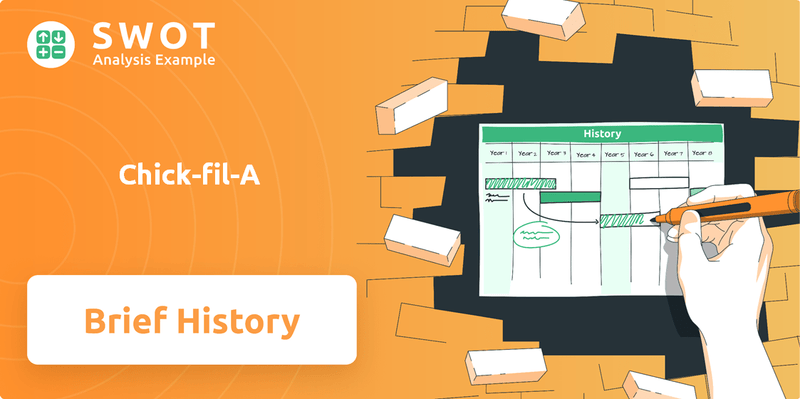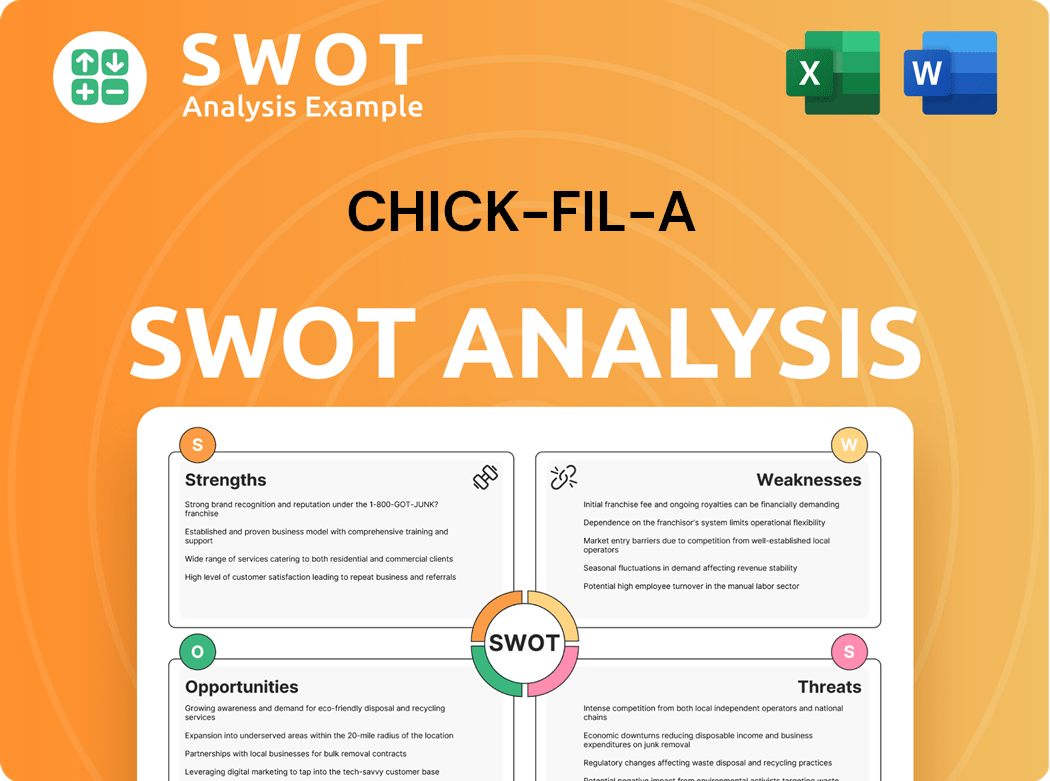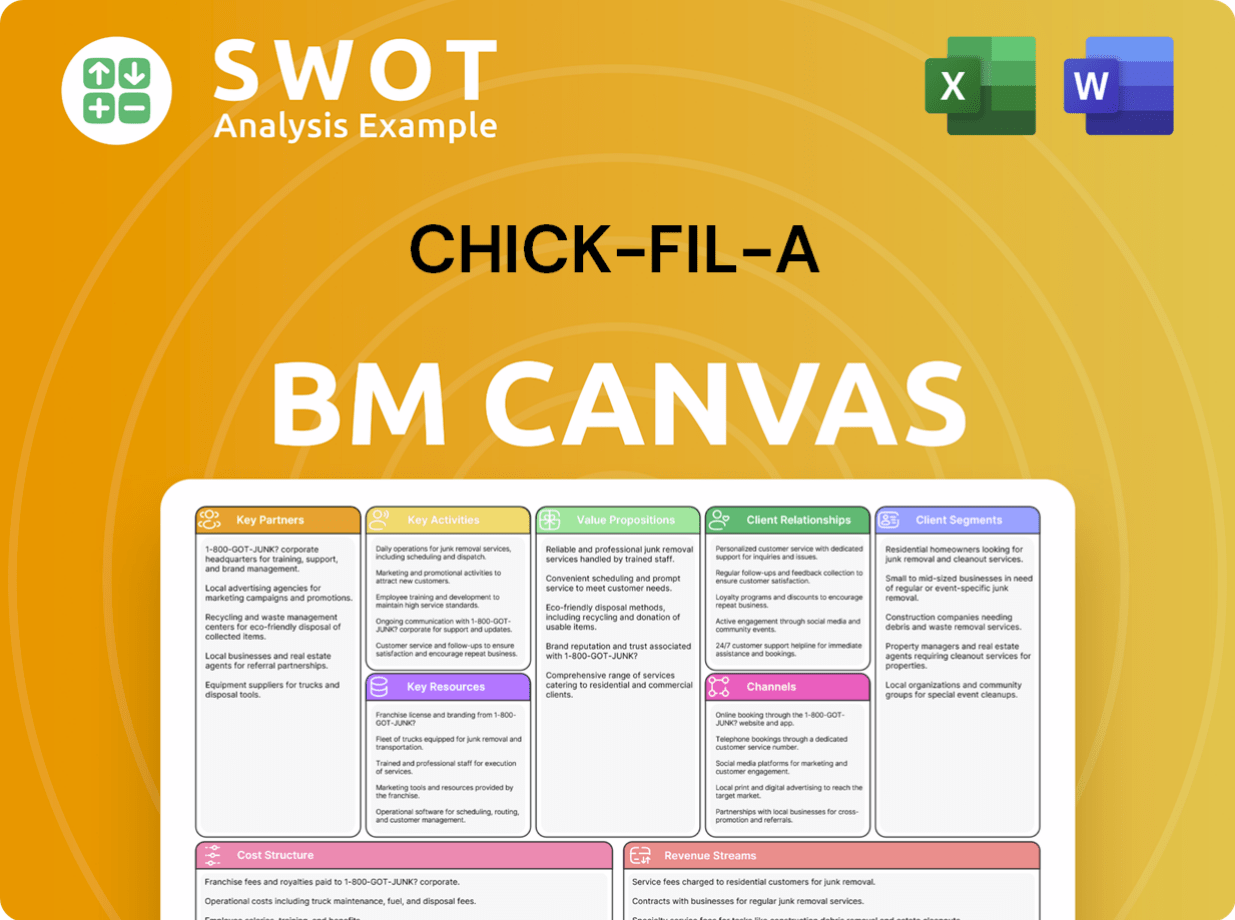Chick-fil-A Bundle
How Did Chick-fil-A Become a Fast-Food Powerhouse?
From a single diner to a nationwide phenomenon, the Chick-fil-A SWOT Analysis reveals a fascinating story of strategic brilliance. This journey began with a simple chicken sandwich, a revolutionary idea that would transform the quick-service restaurant industry. Explore the Chick-fil-A history and discover how Truett Cathy built an empire.

The Chick-fil-A origins can be traced back to 1946, when Chick-fil-A founder Truett Cathy opened the Dwarf Grill in Georgia, setting the stage for a remarkable Chick-fil-A timeline. Understanding the early days of Chick-fil-A and how Chick-fil-A started provides crucial context for its subsequent Chick-fil-A growth and expansion. This article will delve into the brief history of Chick-fil-A restaurants, exploring its business model evolution and significant milestones.
What is the Chick-fil-A Founding Story?
The Chick-fil-A history began on May 23, 1946. This is when S. Truett Cathy and his brother, Ben Cathy, opened the Dwarf Grill in Hapeville, Georgia. Truett Cathy, a devout Baptist, brought a diverse entrepreneurial background to the restaurant business.
The early days focused on providing quick, high-quality meals. The primary target was workers from the nearby Ford Assembly Plant and Delta Airlines. The original business model was a diner, offering a wide range of menu items.
A significant turning point occurred in 1964. Truett Cathy perfected the chicken sandwich. He developed a method to cook boneless, skinless chicken quickly using a pressure cooker. This innovation led to the creation of the Chick-fil-A Chicken Sandwich. This became the foundation of the brand. The name 'Chick-fil-A' was chosen to highlight the 'chicken fillet' of 'Grade A' quality. Initial funding came from Cathy's savings and a loan. This reflected a bootstrapped approach. Challenges included long hours and intense competition. Cathy's dedication to customer service and innovative food preparation set the stage for future success.
Here are some important facts about the early days of Chick-fil-A:
- The Dwarf Grill was the original restaurant.
- The Chick-fil-A Chicken Sandwich was introduced in 1964.
- Truett Cathy's business approach emphasized customer service.
- The company's early success was built on innovation and quality.
Chick-fil-A SWOT Analysis
- Complete SWOT Breakdown
- Fully Customizable
- Editable in Excel & Word
- Professional Formatting
- Investor-Ready Format

What Drove the Early Growth of Chick-fil-A?
The early growth of Chick-fil-A, a key part of the Revenue Streams & Business Model of Chick-fil-A, was marked by strategic decisions that shaped its future. Following the success of the chicken sandwich, S. Truett Cathy opened the first Chick-fil-A restaurant in 1967. This move shifted the business model toward a mall-based, quick-service concept, allowing for broader audience reach.
Chick-fil-A's initial expansion strategy focused on licensing agreements within mall food courts. This approach allowed the company to capitalize on high foot traffic and establish a presence in various locations. By the 1970s and 1980s, the brand had expanded its footprint across shopping malls in the Southeast, solidifying its market position.
The company differentiated itself through a limited menu centered around its signature chicken sandwich, emphasizing consistent quality and exceptional customer service. This focus helped build a loyal customer base and set the stage for future growth. The early days of Chick-fil-A were defined by these core principles.
A key aspect of Chick-fil-A's early operations was its unique philosophy, including the practice of being closed on Sundays. This decision, rooted in religious beliefs, has become a hallmark of the brand. This practice, along with a focus on quality and service, helped define the company's identity.
Early team expansions involved building operational and training support for new licensees. The market responded positively, with customers appreciating the food quality and friendly service. This period of deliberate expansion laid the foundation for Chick-fil-A's transition to standalone restaurants and its nationwide presence.
Chick-fil-A PESTLE Analysis
- Covers All 6 PESTLE Categories
- No Research Needed – Save Hours of Work
- Built by Experts, Trusted by Consultants
- Instant Download, Ready to Use
- 100% Editable, Fully Customizable

What are the key Milestones in Chick-fil-A history?
The Chick-fil-A history is marked by significant milestones that have shaped its growth and impact on the fast-food industry.
| Year | Milestone |
|---|---|
| 1946 | Truett Cathy opens the Dwarf Grill, the precursor to Chick-fil-A, in Hapeville, Georgia. |
| 1967 | The first Chick-fil-A restaurant opens inside a mall in Atlanta, Georgia, marking the official start of the company. |
| 1986 | Chick-fil-A begins opening standalone restaurants, expanding beyond mall locations and offering drive-thru services. |
| 1994 | Chick-fil-A introduces its "Eat Mor Chikin" advertising campaign, which becomes a signature element of its brand. |
| 2000s-2024 | Continued expansion across the United States, with a focus on customer service and product quality, leading to high customer satisfaction ratings. |
Innovations have been central to the success of the company. A key innovation was the development of the pressure cooker, which enabled the consistent and efficient preparation of its signature chicken sandwich.
The pressure cooker was a groundbreaking innovation, allowing for the quick and uniform cooking of chicken, ensuring consistent quality across all locations.
The shift to standalone restaurants provided greater operational flexibility, including drive-thru services, significantly increasing accessibility and market reach.
The "Eat Mor Chikin" advertising campaign became a distinctive and memorable aspect of the brand, enhancing brand recognition and customer engagement.
Chick-fil-A has invested in digital platforms for ordering and delivery, adapting to evolving consumer preferences for convenience and accessibility.
The company has consistently introduced new menu items and variations, such as the Spicy Chicken Sandwich and seasonal offerings, to keep the menu fresh and appealing.
Chick-fil-A has focused on employee training and development programs to maintain high service standards and foster a positive work environment.
The company has faced several challenges throughout its Chick-fil-A history. Competition from larger fast-food chains and evolving consumer preferences have required continuous adaptation and innovation.
Facing intense competition from larger fast-food chains necessitates ongoing efforts to differentiate through product quality, service, and marketing.
Past controversies related to charitable donations have prompted the company to refine its public image and communication strategies, emphasizing community impact.
The need to adapt to changing consumer tastes and preferences, including health-conscious options and digital ordering, requires continuous menu and operational adjustments.
Like other fast-food chains, Chick-fil-A has faced supply chain disruptions, requiring careful management of inventory and supplier relationships to maintain operations.
Attracting and retaining employees in a competitive labor market has been a persistent challenge, necessitating investments in employee benefits and work environment improvements.
Ensuring consistent product quality and service standards across a growing number of locations requires rigorous training, quality control, and operational oversight.
Chick-fil-A Business Model Canvas
- Complete 9-Block Business Model Canvas
- Effortlessly Communicate Your Business Strategy
- Investor-Ready BMC Format
- 100% Editable and Customizable
- Clear and Structured Layout

What is the Timeline of Key Events for Chick-fil-A?
The Chick-fil-A history is marked by strategic growth and innovation, starting with its Chick-fil-A origins in the mid-20th century. The Chick-fil-A timeline reflects a journey from a small diner to a national fast-food chain and beyond.
| Year | Key Event |
|---|---|
| 1946 | Chick-fil-A founder, S. Truett Cathy, opens the Dwarf Grill in Hapeville, Georgia. |
| 1964 | S. Truett Cathy develops the Chick-fil-A Chicken Sandwich. |
| 1967 | The first Chick-fil-A restaurant opens in Greenbriar Mall, Atlanta. |
| 1973 | The Chick-fil-A corporate office is established. |
| 1986 | The first standalone Chick-fil-A restaurant opens. |
| 1995 | Chick-fil-A launches its famous 'Eat Mor Chikin' cow campaign. |
| 2006 | Chick-fil-A opens its first restaurant outside the United States in Canada. |
| 2014 | Founder S. Truett Cathy passes away, with his son Dan Cathy taking over as CEO. |
| 2020 | Chick-fil-A accelerates digital innovation and contactless service during the pandemic. |
| 2023 | Chick-fil-A reports over $18.8 billion in system-wide sales. |
| 2024 | The company continues its expansion, with plans for new locations and increased presence in various markets. |
Chick-fil-A is focused on expanding both domestically and internationally. The company aims to increase its presence in existing markets while exploring new geographical opportunities. This includes opening new locations and potentially entering new countries.
Digital innovation remains a key strategic initiative for Chick-fil-A. Ongoing investments in mobile ordering, delivery services, and personalized customer experiences are expected. These efforts are designed to meet the evolving demands of consumers.
Industry trends, such as the demand for convenience, healthier options, and sustainable practices, will influence Chick-fil-A's future. These trends will likely shape product development and operational strategies. The company will adapt to meet these evolving consumer preferences.
Analysts predict continued strong performance due to brand loyalty, efficient operations, and high customer satisfaction. The company's commitment to its founding vision is expected to ensure enduring success. Chick-fil-A's focus on quality and service is key.
Chick-fil-A Porter's Five Forces Analysis
- Covers All 5 Competitive Forces in Detail
- Structured for Consultants, Students, and Founders
- 100% Editable in Microsoft Word & Excel
- Instant Digital Download – Use Immediately
- Compatible with Mac & PC – Fully Unlocked

Related Blogs
- What is Competitive Landscape of Chick-fil-A Company?
- What is Growth Strategy and Future Prospects of Chick-fil-A Company?
- How Does Chick-fil-A Company Work?
- What is Sales and Marketing Strategy of Chick-fil-A Company?
- What is Brief History of Chick-fil-A Company?
- Who Owns Chick-fil-A Company?
- What is Customer Demographics and Target Market of Chick-fil-A Company?
Disclaimer
All information, articles, and product details provided on this website are for general informational and educational purposes only. We do not claim any ownership over, nor do we intend to infringe upon, any trademarks, copyrights, logos, brand names, or other intellectual property mentioned or depicted on this site. Such intellectual property remains the property of its respective owners, and any references here are made solely for identification or informational purposes, without implying any affiliation, endorsement, or partnership.
We make no representations or warranties, express or implied, regarding the accuracy, completeness, or suitability of any content or products presented. Nothing on this website should be construed as legal, tax, investment, financial, medical, or other professional advice. In addition, no part of this site—including articles or product references—constitutes a solicitation, recommendation, endorsement, advertisement, or offer to buy or sell any securities, franchises, or other financial instruments, particularly in jurisdictions where such activity would be unlawful.
All content is of a general nature and may not address the specific circumstances of any individual or entity. It is not a substitute for professional advice or services. Any actions you take based on the information provided here are strictly at your own risk. You accept full responsibility for any decisions or outcomes arising from your use of this website and agree to release us from any liability in connection with your use of, or reliance upon, the content or products found herein.